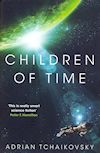A young man relates his incredible history as an unmarried mother to a sympathetic bartender,
who then recruits him into a secret organisation that explains, and causes, all his troubles.
The underlying plot logic is based on
Robert Heinlein’s
1959 short story “—All You Zombies—”.
I can’t say how comprehensible the movie is without knowing the background;
it may need to be viewed twice to pick up earlier clues.
To extend it from a short story, certain elements have been added,
like more details on the secret organisation, the violin case, the Fizzle Bomber, and the loop’s closure.
These additions are all fine, as they tighten the loop.
(I do think it would have been interesting to try to include the organisation’s head in the loop, too,
but that would have been quite a big deviation from the original story.)
The beginning is a little slow, being mostly narration with flashbacks,
but once the narration has caught up to “the present day” (whatever that means in such a time loop)
the action carries along on nicely.
It follows the original short story’s plot very closely,
including the time it is set – the opening bar scene is set in 1970 –
which gives it a retro alternate history vibe, 50 years on from then.
The main deviation is the added ending, which,
amazingly,
improves what is already an almost perfect time loop plot.
On the whole, this is a great realisation of a terse and densely plotted short story.
For all my film reviews, see
my main website.








